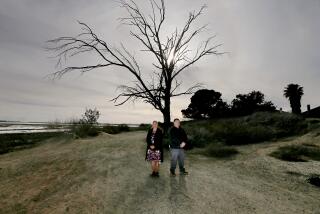Opinion: What California Indians lost under Junipero Serra, soon to be saint
Is there a word for the extinction of cultures? Not the people of those cultures, but the cultures themselves?
I ask because one of the notable consequences of the California mission movement founded by and overseen by Father Junipero Serra was the loss of various Native American cultures, to the point where many Indian groups cannot now get tribal recognition. It seems odd that Pope Francis, known for his cultural sensitivity and appreciation for diversity, has chosen to confer sainthood on Serra, who played such a big role in obliterating indigenous culture in coastal California.
Several years ago, I was honored with an invitation to attend a traditional Acjachemen ceremony in San Onofre State Beach, just south of the Orange County border. The members were celebrating the fact that the Coastal Commission had put a halt to a massive toll-road project that would have encroached on the site of the ancient Acjachemen village of Panhe, which their ancestors had inhabited continuously for 9,000 years, until shortly after the arrival of the Spanish. In fact, it was at Panhe that the first christening took place in California; the actual spot is on Camp Pendleton.
Their situation was in ways a perfect reflection of the uneasy relationship many California Indians have with Serra’s legacy. Like many other native groups, the Acjachemen were forced out of Panhe and other small villages and absorbed into the local mission — in their case, San Juan Capistrano. Their language, many of their ways of life and even their tribal name were erased. They became known as the Juaneño Indians, after the mission, and only recently have reclaimed their ancestral name. They also have been attempting to restore their language and revive its use.
Yet because of the history of evangelism by the Roman Catholic Church, many if not most Acjachemen are Catholic. And though their ancestors were forced to abandon their ways, whatever written records they have of their past come largely from the missionaries, who kept detailed genealogical records. Through those records, many of today’s Acjachemen know which villages were their ancestral homes. Some can trace their roots back to Panhe, which means they know where their ancestors stood 9,000 years ago.
Because the missions mixed different Native American groups together and forced all of them to give up much of their cultural identity, many of these groups cannot meet the requirements of continuous cultural and geographical identity required to be federally recognized tribes, with the many benefits such recognition bestows. It’s one of the most painful ironies in California history — robbed of their culture by white missions the first time, and then, because of that first theft, robbed by the U.S. government a second time.
The pope cited Serra’s role as the “evangelizer of the West” in announcing his canonization. But many see his role more as one of forced conversion rather than persuasive evangelism. I’m sure the pope realizes this; the church has recognized in the past, at least, that there were some serious problems with California’s early mission history. Perhaps that seems like a regrettable but small part of the story from the viewpoint of the Vatican, but here in California, the irreparable harm done to Native Americans is not easily minimized.
Follow the Opinion section on Twitter @latimesopinion
More to Read
A cure for the common opinion
Get thought-provoking perspectives with our weekly newsletter.
You may occasionally receive promotional content from the Los Angeles Times.







